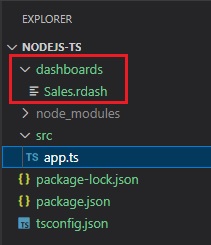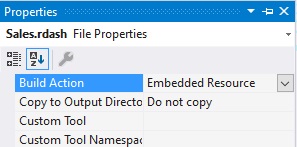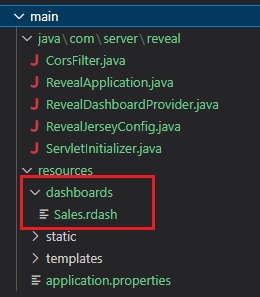Loading Dashboards
Reveal Dashboards are stored on the server. The client application will make a call to the $.ig.RVDashboard.loadDashboard method passing in the name of the dashboard to load. The request for the dashboard is sent to the server and the server will respond to the client with the requested dashboard. The client will take the dashboard provided in the server response, and set the RevealView.dashboard property.
By default, the Reveal SDK uses a convention to load dashboards from a file path. Specifically, the Reveal SDK will look for dashboards in a Dashboards folder in the working directory on the server.
1 - In the server application, create a folder named Dashboards in the working directory and place a dashboard file within the folder.
- ASP.NET
- Java
- Node.js

Java does not currently support a default dashboard loader. You must create a custom dashboard provider.

2 - In the client application, call the $.ig.RevealSdkSettings.setBaseUrl method and pass in your server URL. When debugging, the server URL will be https://localhost followed by a port number. For example:
$.ig.RevealSdkSettings.setBaseUrl("https://localhost:5111/");
Calling the $.ig.RevealSdkSettings.setBaseUrl is required when the server is running on a different URL than the client application. If both the server application and the client application are running on the same URL, this method is not required. This method only needs to be called once.
3 - Make a call to the $.ig.RVDashboard.loadDashboard method and pass the name of the dashboard file without the .rdash extension. This method has a callback which will provide the dashboard being requested from the server. Once you have received the dashboard from the callback, get an instance of the $.ig.RevealView and set the RevealView.dashboard property to the dashboard in the response.
$.ig.RVDashboard.loadDashboard("Sales", (dashboard) => {
var revealView = new $.ig.RevealView("#revealView");
revealView.dashboard = dashboard;
});
The source code to this sample can be found on GitHub.
Custom Dashboard Provider
If the default Dashboards file directory is not an option for your application, you can provide a custom dashboard provider in which to load the dashboards instead.
1 - Create the dashboard provider.
- ASP.NET
- Java
- Node.js
public class DashboardProvider : IRVDashboardProvider
{
public Task<Dashboard> GetDashboardAsync(IRVUserContext userContext, string dashboardId)
{
throw new NotImplementedException();
}
public Task SaveDashboardAsync(IRVUserContext userContext, string dashboardId, Dashboard dashboard)
{
throw new NotImplementedException();
}
}
public class DashboardProvider implements IRVDashboardProvider {
@Override
public InputStream getDashboard(IRVUserContext userContext, String dashboardId) throws IOException {
return null;
}
@Override
public void saveDashboard(IRVUserContext arg0, String arg1, InputStream arg2) throws IOException {
return null;
}
}
const dashboardProvider = async (userContext:IRVUserContext | null, dashboardId: string) => {
return null;
}
2 - Register the dashboard provider with the Reveal SDK.
- ASP.NET
- Java
- Node.js
builder.Services.AddControllers().AddReveal( builder =>
{
builder.AddDashboardProvider<DashboardProvider>();
});
RevealEngineInitializer.initialize(new InitializeParameterBuilder().
setDashboardProvider(new DashboardProvider()).
build());
const revealOptions: RevealOptions = {
dashboardProvider: dashboardProvider,
};
app.use("/", reveal(revealOptions));
Example: Load from File Path
- ASP.NET
- Java
- Node.js
public class DashboardProvider : IRVDashboardProvider
{
public Task<Dashboard> GetDashboardAsync(IRVUserContext userContext, string dashboardId)
{
var filePath = Path.Combine(Environment.CurrentDirectory, $"MyDashboardsFolder/{dashboardId}.rdash");
var dashboard = new Dashboard(filePath);
return Task.FromResult(dashboard);
}
public Task SaveDashboardAsync(IRVUserContext userContext, string dashboardId, Dashboard dashboard)
{
throw new NotImplementedException();
}
}
public class RevealDashboardProvider implements IRVDashboardProvider {
@Override
public InputStream getDashboard(IRVUserContext userContext, String dashboardId) throws IOException {
InputStream dashboardStream = new FileInputStream("dashboards/" + dashboardId + ".rdash");
return dashboardStream;
}
@Override
public void saveDashboard(IRVUserContext arg0, String arg1, InputStream arg2) throws IOException {
}
}
const dashboardProvider = async (userContext:IRVUserContext | null, dashboardId: string) => {
return fs.createReadStream(`myDashboards/${dashboardId}.rdash`);
}
The source code to this sample can be found on GitHub.
Example: Load from Resource
1 - Embed a Reveal dashboard .rdash file as a resource in your server application.
- ASP.NET
- Java
To embed a Reveal dashboard .rdash file as a resource in your ASP.NET server application, open the Properties for the dashboard file in Visual Studio, and set the Build Action of the .rdash file to EmbeddedResource.

To embed a Reveal dashboard .rdash file as a resource in your Java server application, place the dashboard file in the resources directory.

2 - Create the dashboard provider.
- ASP.NET
- Java
public class DashboardProvider : IRVDashboardProvider
{
public Task<Dashboard> GetDashboardAsync(IRVUserContext userContext, string dashboardId)
{
var resource = Assembly.GetExecutingAssembly().GetManifestResourceStream($"RevealSdk.Server.Dashboards.{dashboardId}.rdash");
using (resource)
{
var dashboard = new Dashboard(resource);
return Task.FromResult(dashboard);
}
}
public Task SaveDashboardAsync(IRVUserContext userContext, string dashboardId, Dashboard dashboard)
{
throw new NotImplementedException();
}
}
The name of the resource you will provide in the Assembly.GetManifestResourceStream method must include the namespace and file name of the .rdash file.
public class RevealDashboardProvider implements IRVDashboardProvider {
@Override
public InputStream getDashboard(IRVUserContext userContext, String dashboardId) throws IOException {
InputStream dashboardStream = getClass().getResourceAsStream("/dashboards/" + dashboardId + ".rdash");
return dashboardStream;
}
@Override
public void saveDashboard(IRVUserContext arg0, String arg1, InputStream arg2) throws IOException {
}
}
The source code to this sample can be found on GitHub.
Example: Load From JSON
For advanced users, or users that serialize Reveal dashboards into .json files instead of .rdash files, you can load these JSON based files using the Dashboard.LoadFromJsonAsync method on the server application.
- ASP.NET
- Java
- Node.js
public class DashboardProvider : IRVDashboardProvider
{
public Task<Dashboard> GetDashboardAsync(IRVUserContext userContext, string dashboardId)
{
var filePath = Path.Combine(Environment.CurrentDirectory, $"Dashboards/{dashboardId}.json");
var json = File.ReadAllText(filePath);
var dashboard = Dashboard.FromJsonString(json);
return Task.FromResult(dashboard);
}
public Task SaveDashboardAsync(IRVUserContext userContext, string dashboardId, Dashboard dashboard)
{
throw new NotImplementedException();
}
}
This feature is currently not supported by Java
This feature is currently not supported by Node.js
Manipulating or changing the contents of a Reveal dashboard after it has been serialized to JSON can break the integrity of the dashboard and cause irreversible damage to the contents of the dashboard. This could result in runtime exceptions being thrown in your application due to errors and/or a failure to load the dashboard.
The source code to this sample can be found on GitHub.